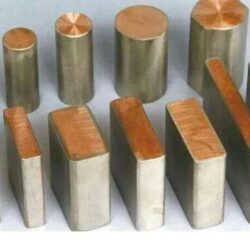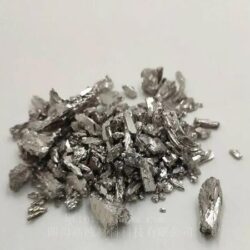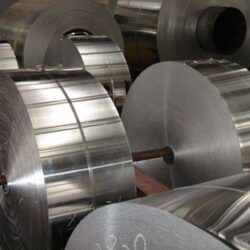Aluminium alloys (or aluminum alloys; see spelling differences) are alloys in which aluminium (Al) is the predominant metal. The typical alloying elements are copper, magnesium, manganese, silicon, tin and zinc. There are two principal classifications, namely casting alloys and wrought alloys, both of which are further subdivided into the categories heat-treatable and non-heat-treatable. About 85% of aluminium is used for wrought products, for example rolled plate, foils and extrusions. Cast aluminium alloys yield cost-effective products due to the low melting point, although they generally have lower tensile strengths than wrought alloys. The most important cast aluminium alloy system is Al–Si, where the high levels of silicon (4.0–13%) contribute to give good casting characteristics. Aluminium alloys are widely used in engineering structures and components where light weight or corrosion resistance is required.
Aluminum alloys are incredibly versatile, sturdy, and reliable. For this reason, they are very sought-after in engineering, construction, and automotive applications, making for one of the most widespread metal materials, alongside steel. Keep reading to learn more about the qualities, applications, and unique characteristics of aluminum alloys. While aluminum presents some amazing properties as a pure element, it might not be strong enough for the high-durability purpose. For this reason, it can be combined with other elements in order to form alloys, which are exponentially more durable and suitable for industrial applications. Aluminum alloys are particularly desirable when engineers seek to reduce the weight of an item (for example, an airplane) without compromising in terms of strength.
What are aluminum alloys?
An “alloy” is a blend of different metallic elements, often created to enhance the strength and durability of the material. An aluminum alloy typically consists of the latter as the main metal in the blend, often combined with other elements, such as silicon, tin, manganese, or even copper, tin, and magnesium, depending on the desired application. With the right combination of elements, aluminum can acquire a lot more strength, and in some cases, it could even outperform steel. Alloys bring the same benefits of pure aluminum, and they are also relatively cost-effective because they have a lower melting point.
Aluminium is most commonly alloyed with copper, zinc, magnesium, silicon, manganese and lithium. Small additions of chromium, titanium, zirconium, lead, bismuth and nickel are also made and iron is invariably present in small quantities.
There are over 300 wrought alloys with 50 in common use. They are normally identified by a four figure system which originated in the USA and is now universally accepted. Table 1 describes the system for wrought alloys. Cast alloys have similar designations and use a five digit system.
Table 1. Designations for wrought aluminium alloys.
| Alloying Element | Wrought |
|---|---|
| None (99%+ Aluminium) | 1XXX |
| Copper | 2XXX |
| Manganese | 3XXX |
| Silicon | 4XXX |
| Magnesium | 5XXX |
| Magnesium + Silicon | 6XXX |
| Zinc | 7XXX |
| Lithium | 8XXX |
For unalloyed wrought aluminium alloys designated 1XXX, the last two digits represent the purity of the metal. They are the equivalent to the last two digits after the decimal point when aluminium purity is expressed to the nearest 0.01 percent. The second digit indicates modifications in impurity limits. If the second digit is zero, it indicates unalloyed aluminium having natural impurity limits and 1 through 9, indicate individual impurities or alloying elements.
For the 2XXX to 8XXX groups, the last two digits identify different aluminium alloys in the group. The second digit indicates alloy modifications. A second digit of zero indicates the original alloy and integers 1 to 9 indicate consecutive alloy modifications.
Strength of Aluminium Alloys
By appropriate alloying and treatment, aluminium alloys are available in a variety of strengths.
Some aluminium alloys have strength as high as 300 MPa and are stronger than some steels.
Strength may be selected to match product needs.
High Strength-To-Weight Ratio of Aluminium Alloys
In terms of strength to weight ratio, aluminium outperforms other materials. Aluminium’s advantage in this respect founded the modern aerospace industry and serves widely in various forms of transportation and other applications.
Corrosion Resistance of Aluminium Alloys
When aluminium is exposed to air, a thin oxidised film forms on the surface, protecting the metal from corrosion. When scratched, the layer rapidly reforms retaining the protection. This feature is utilised in construction, buildings and household utensils.
Most popular applications of aluminum alloy
> Aerospace and automotive
You’ll often find aluminum alloys within the context of engineering, as well as the construction of light-weight components and corrosion-resistant metal parts. One of the industries that highly relies on aluminum alloys in aerospace, as well as the automotive industry. In this particular context, aluminum alloy is becoming an increasingly important material. This is because it can reduce the weight of a vehicle, thus maximizing its efficiency and fuel sustainability in the long run. In addition to that, the durability of the aluminum alloy makes it a safety-conscious option as well, since it performs really well on crash tests and exceeds the requirements of most safety regulations all around the world. Aluminum is much lighter than steel (about one-third its weight) and it enables manufacturers to build strong metal parts, without adding unnecessary weight to put a damper on the performance of their vehicles.
> Building and constructions
High-Strength aluminum alloy is also a very popular implement in building construction. Steel still remains one of the most fundamental materials in construction, but aluminum alloys are definitely a very close second. When building modern skyscrapers and structures, it is quite important to account for strength and safety. The added benefits of high corrosion resistance and low flammability, as well as aluminum’s natural insulation property, make this a perfect choice. In recent years, aluminum has been highly rated internationally for use in structures where the outbreak of fire might be a possibility. It takes roughly two times as much heat to raise the temperature of aluminum by one single degree when compared to a similar mass of steel. Moreover, Aluminum doesn’t burn in air, nor does it cause smoke and other toxic fumes.
> Electrical and electronic engineering
You’ll often find aluminum in electrical and electronic engineering applications, due to the fact that it doesn’t cause any magnetic interference. Aluminum, unlike other metal, is actually non-ferromagnetic, making it very valuable and important for electronic manufacturing, electrical shielding, and other applications.
> and moreover…
In addition to being extremely sturdy, aluminum alloy, especially when magnesium is involved, is less flammable when compared to other alloys, and less susceptible to corrosion. It is very important to choose the best aluminum alloy for each given application, accounting for factors such as malleability, density, ductility, and tensile strength, among other things.


